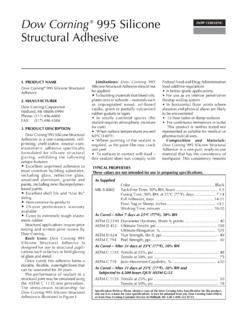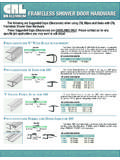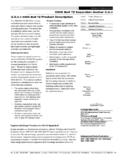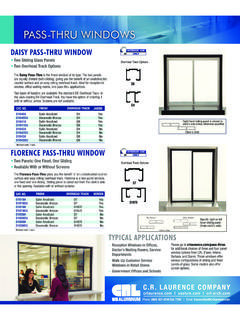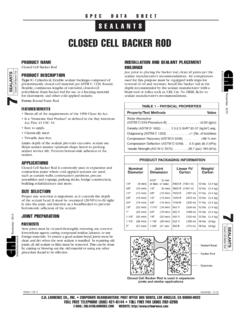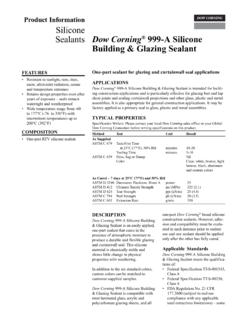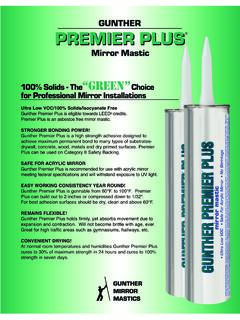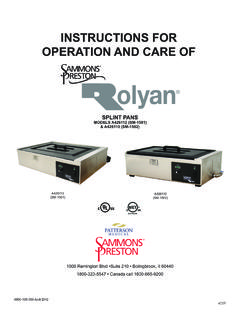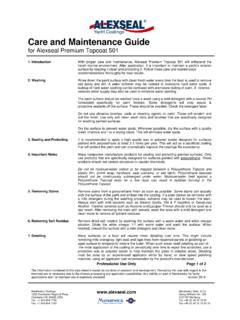Transcription of TECHNICAL BULLETIN - C.R. Laurence
1 TECHNICAL BULLETIN Cleaning Metal finishes Caution: In polishing or cleaning metals, always follow the polish manufacturer s recommended instructions for safety and use, and carefully review all Material Safety Data Sheets applicable to such products. Special precautions must be taken with certain cleaners and polishing agents in order to avoid personal injury due to exposure to such products. Acidic or alkaline cleaning materials or solvents may damage gunned sealants, vinyl, EDPM or neoprene glazing strips and cause water leakage into the building. These materials may also damage insulating unit sealants and cause premature failure of the insulating units. Acidic or alkaline cleaning materials or solvents may also damage Brass or Bronze metal finishes . Care must be taken to prevent this type of damage. Anodized Aluminum: Proper care can provide years of service with minimum maintenance.
2 Dust and grime should be removed by regular cleaning. Use a mild, non-abrasive soap or detergent and water. To remove tar or dirt build-up, use SofScrub followed by a soap and water cleaning and fresh water rinse. Acid or alkali cleaners should not be used as they may attack the anodic coating. After cleaning, surfaces should be wiped dry with a clean absorbent material, especially in hard water areas. Painted Aluminum: Dust and grime should be removed by regular cleaning. Use a mild, non-abrasive soap or detergent and water. Wet the surface thoroughly and clean gently using a soft, clean sponge or cloth. Follow with a fresh water rinse. Surfaces should be wiped dry with a soft, clean cloth. Contact the paint manufacturer for instructions on removing tar, sealants or dirt build-up. Do not use solvents or abrasive cleaners on painted surfaces without approval from the paint manufacturer.
3 Mirror Polished Stainless Steel (Alloy 304): Mirror polished stainless steel finishes should be cleaned with a concentrated foam spray cleaner (such as Sprayway , or a similar product) and wiped with a clean, dry cloth. Such foam cleaners can be used as often as necessary. Liquid solutions may cloud or scratch polished stainless steel finishes . Satin Polished Stainless Steel (Brushed) (Alloy 304): Satin polished stainless steel finishes should be wiped clean with a mild soap and water solution, rinsed with clean water and wiped with a clean, dry cloth for occasional smudges. For periodic maintenance, satin stainless steel can be rubbed with an abrasive pad (such as a #9650 General Purpose Rubbing Pad by 3M). The finish should always be rubbed in the same direction as the grain texture. Mirror Polished Brass (or Bronze) (Alloy 220/260/280/385/464) Mirror polished copper alloys should be periodically cleaned, when it begins to tarnish, with a brass polishing cream that uses low level abrasives (such as Brasso , or a similar product).
4 The liquid or cream polish should be used in accordance with the manufacturer s recommended instructions for safety and use. Do not use circular motions when polishing. If the brass is heavily stained or tarnished, please contact a brass manufacturer for acceptable cleaning methods. After cleaning and removal of stains, polish with an appropriate metal polish. Appropriate metal polishes can be obtained from janitorial supply houses or home owner s hardware supply stores. Satin Polished Brass (or Bronze) (Alloy 220/260/280/385/464): Satin polished copper alloy finishes should be cleaned by rubbing with an abrasive pad (such as #9650 General Purpose Rubbing Pad by 3M). The finish should always be rubbed in the same direction as the grain texture. Satin, Oxidized and Oil Rubbed Bronze (Alloy 385/464): Satin, oxidized and oil rubbed bronze should be periodically maintained by wiping with liquid lemon oil, such as the type used on wood.
5 It should be applied with a clean cloth. The lemon oil should not be wiped dry after applying, but allowed to air dry naturally. finishes Coated with Clear Baked Enamel or Clear Enamel or Clear Lacquer: finishes coated with a clear baked enamel, clear enamel or clear lacquer coating can be cleaned periodically by gently wiping with a mild soap and water solution, rinsed with clean water and wiped with a clean, dry cloth. GENERAL INFORMATION & MAINTENANCE OF STAINLESS STEEL PRODUCTS Stainless Steel is a common chromium/nickel alloy steel used in thousands of products from ocean-going craft to tableware. A protective chromium oxide film forms on its surface which gives stainless its superior corrosion-resistant property. When properly maintained, stainless provides excellent luster, strength and durability. And, in most applications, stainless will not rust or stain even after many years of service.
6 However, Stainless Steel is NOT stain or rust proof. Atmospheric conditions, environmental pollution, or even close proximity to a body of water can all be contributing factors to corrosion. Stainless will also discolor, rust or corrode if used in contact with chloride salts, sulfides or other rusting metals. Proper care and maintenance of stainless in marine environments, polluted surroundings, salted highways, or other situations where stainless may be exposed to corrosive elements will help keep your stainless products beautiful and functional for years to come. Unfortunately, Stainless Steel does not necessarily remain stainless without periodic maintenance. The best way to remove mild corrosion is with chrome cleaner. Apply like you would a wax, let dry, and rub vigorously to remove spots and restore the luster.
7 On a satin finish you can use a Scotch-Brite pad to remove tougher spots and help restore the original sheen. To insure lasting beauty, a good quality car wax should be applied. CARE AND CLEANING Mirror Polished Stainless Steel: Mirror polished stainless steel finishes should be cleaned with a foam spray cleaner, such as: CRL Sprayway - Stainless Steel Polish & Cleaner SW841 cleans, polishes and protects stainless steel without hard rubbing and polishing. Resists finger prints, grease and water splatter. Helps preserve the factory finish. and wiped with a clean, dry cloth, such as: CRL Lint Free Shop Wipes 1550 are made with four plies of strong, white paper and reinforced in both directions with an extra ply of tough nylon. These rugged towels will stand up to the most demanding shop work. 1550 wipes can absorb many times their weight in liquids.
8 CRL Glass Wipes are virtually lintfree. Such foam cleaners can be used as often as necessary. Liquid solutions may cloud or scratch polished stainless steel finishes . For periodic maintenance, mirror stainless can be polished with: CRL Autosol Shine 1188AS cleans, restores and polishes all metal surfaces and will protect against corrosion and tarnishing. Mild abrasives help to remove built-up tarnish, oxidation and even rust, leaving behind a protective coating, which helps to condition the metal and protect against corrosion while providing a longer lasting shine Do not use circular motions when polishing. Satin Polished Stainless Steel (Brushed): Satin polished stainless steel finishes should be cleaned like Mirror polished Stainless Steel, just with circular motions in the same direction as the grain texture.
9 For periodic maintenance, satin stainless steel can be rubbed with an abrasive pad such as Scotch-Brite General Purpose Hand Pad 7447 by 3M, or Scotch-Brite Ultra Fine Hand Pad 7448 by 3M, or Scotch-Brite General Purpose Scrubbing Pad 9650 by 3M. The finish should always be rubbed in the same direction as the grain. CRL Scratch-B-Gone Kits return brushed stainless steel surfaces to new condition in cases of scuffs, fine scratches, light or deep scratches, chemical discoloration, oxidation, and color distortion caused by heat scorching or welding. Easy, fast and simple to use, the Scratch-B-Gone kits combine special open weave, abrasive loaded pads, with Ultra Shine cutting lubricant and surface oxidant to return the brushed 'warm look' and to blend the repaired surface with surrounding areas. These surface restoration kits are available in two sizes (Basic Professional, Cat.)
10 No. SBG1; or the larger Master Professional, Cat. No. SBG2) and come with complete instructions and a tutorial DVD. Here are some more tips on keeping your stainless clean and rust-free: Always - Clean Stainless frequently with soap and water. Any cleaner safe for glass is usually safe for stainless. NEVER - Use coarse abrasives like sandpaper or steel wool on stainless. They may actually cause rusting. NEVER - Clean with mineral acids or bleaches. NEVER - Leave Stainless in contact with iron, steel, or other metals which cause contamination leading to rust or corrosion. Questions, comments, or suggestions, please contact CRL TECHNICAL Sales. rev 6/15/10

